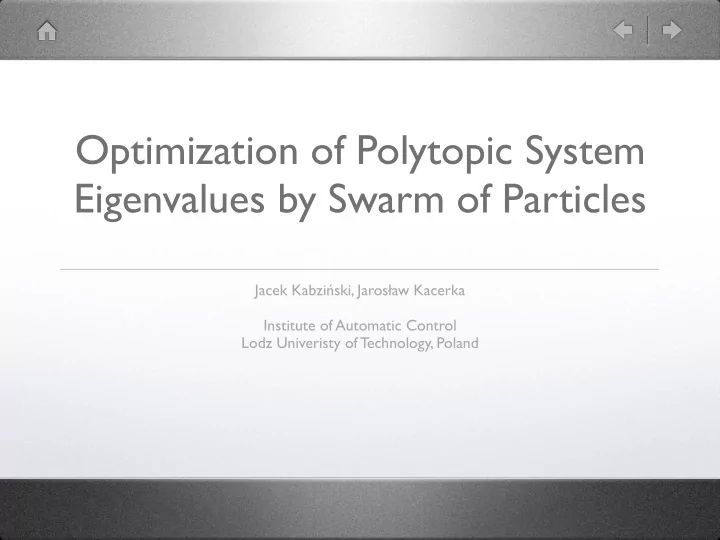

Optimization of Polytopic System Eigenvalues by Swarm of Particles Jacek Kabzi ń ski, Jaros ł aw Kacerka Institute of Automatic Control Lodz Univeristy of Technology, Poland
Plan • Introduction • Eigenvalue optimization • Linear polytopic systems • Problem formulation and features • Proposed (U)PSO modifications • Numerical experiments results • Conclusions • Discussion
Eigenvalue optimization • fascinating and continuous challenge • most popular problem: minimization of maximum real part of system eigenvalues • applications: physic, chemistry, structural design, mechanics, etc.
Eigenvalue optimization • eigenvalues of dynamic systems: • measure of robustness • information regarding stability/instability
Eigenvalue optimization • symmetric matrices: • may be solved e.g. by convex optimization Blanco, A.M., Bandoni, J.A.: Eigenvalue and Singular Value Optimization. In: ENIEF 2003 - XIII Congreso sobre Métodos Numéricos y sus Aplicaciones, pp. 1256–1272 (2003) • non-symmetric matrices: • non-convex • non-differentiable • multiple local optima
Linear polytopic system • system matrix: • in a convex hull of vertices: A 1 , ..., A N • combination coefficients: α 1 , ..., α N
Problem formulation
Problem features • N vertices • N-1 optimization variables • stable vertices ⇏ stable polytopic system 0.2863 -2.4363 • non-convex, non-differentiable, several local minima
Problem features • hard constraints • global minimum located on boundary or vertex
Particle Swarm Optimization • stochastic optimization algorithm based on social simulation models • multiple modifications, selected: UPSO • combines exploration and exploitation abilities • superiority in terms of success rate and number of function evaluations Parsopoulos, K.E., Vrahatis, M.N.: UPSO: A unified particle swarm optimization scheme. In: Proc. Int. Conf. Comput. Meth. Sci. Eng. (ICCMSE 2004). Lecture Series on Computer and Computational Sciences, vol. 1, pp. 868–873. VSP International Science Publishers, Zeist (2004)
Proposed modifications (1) Constraints - initial position in N- 1 dimensional simplex • algorithm: • random position in N- 1 dimensional unit hypercube • if divide by random coefficient bigger than :
Proposed modifications (2) Constraints: • hard - any point outside simplex is infeasible • global minimum often on simplex face or vertex • modification: ability to slide along face or edge
Proposed modifications Algorithm: • previous position: • new position: • calculate minimum distance t min from to boundaries: • replace new position with intersection point: • neutralize velocity component orthogonal to boundary hyper-plane: • for - appropriate component zeroed • for - velocity set to parallel component
Numerical experiments • 150 random generated problems • n ∈ [2,6], N ∈ [3,5], A ij ∈ [-5,5] • every problem sampled at 0.1 resolution + local optimizer: number of local minima, one “global” minimum • 1 to 20 local minima (single minimum in 20% of problems) • global minimum at space boundary - 50% of problems
Numerical experiments • For every problem 50 executions of: • proposed constrained UPSO (C-UPSO) • UPSO constrained by penalty function • Search successful if best fitness close to global minimum
Results • success rate: 5% higher for C-UPSO • convergence: C-UPSO up to 50% faster • similar influence of number of minima on both algorithms
Results • global minimum on the boundary: • higher success rate of C-UPSO • 60% less iterations of C-UPSO
Conclusions • proposed two modifications of PSO: • initialization constrained to N-1 dimensional simplex • ability to slide along boundary • increase in success rate and convergence • applicable to other eigenvalue optimization problems
Recommend
More recommend